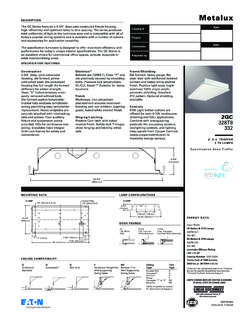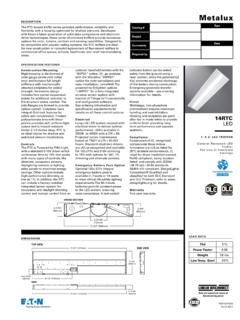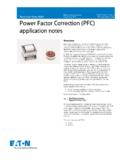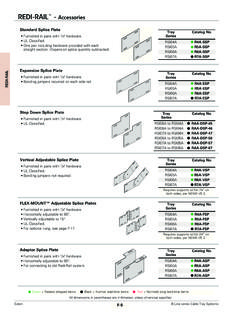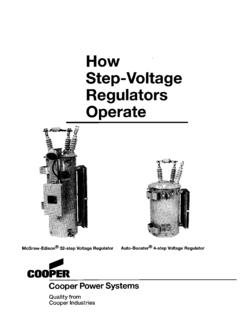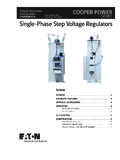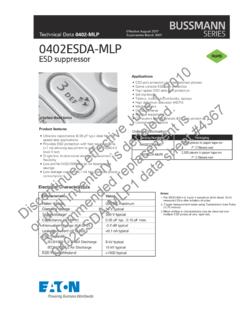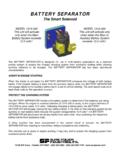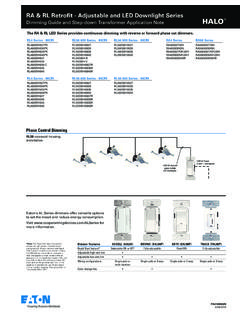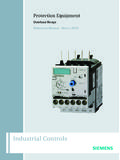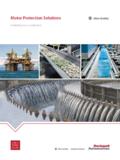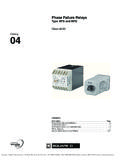Transcription of Fuseology - Cooper Industries
1 11 There are many advantages to using these fuses. Unlike single-element fuses,the Cooper Bussmann dual-element, time-delay fuses can be sized closer toprovide both high performance short circuit protection and reliable overloadprotection in circuits subject to temporary overloads and surge currents. ForAC motor loads, a single-element fuse may need to be sized at 300% of anAC motor current in order to hold the starting current. However, dual-element,time-delay fuses can be sized much closer to motor loads. For instance, it is generally possible to size Fusetron dual-element fuses, FRS-R and FRN-Rand Low-Peak dual-element fuses, LPS-RK_SP and LPN-RK_SP, at 125%and 130% of motor full load current, respectively.
2 Generally, the Low-Peakdual-element fuses, LPJ_SP, and CUBEFuse , TCF, can be sized at 150% ofmotor full load amps. This closer fuse sizing may provide many advantagessuch as: (1) smaller fuse and block, holder or disconnect amp rating and physical size, (2) lower cost due to lower amp rated devices and possiblysmaller required panel space, (3) better short circuit protection less short-circuit current let-through energy, and (4) potential reduction in the the short-circuit current is in the current-limiting range of a fuse, it is notpossible for the full available short-circuit current to flow through the fuse it sa matter of physics.
3 The small restricted portions of the short circuit elementquickly vaporize and the filler material assists in forcing the current to fuse is able to limit the short-circuit protection must be reliable and sure. Whether it is the first day ofthe electrical system or thirty, or more, years later, it is important that overcurrent protective devices perform under overload or short circuit conditions as intended. Modern current-limiting fuses operate by very simple,reliable principles. 2005 Cooper BussmannFuseologyDual-Element, Time-Delay Fuse OperationShort circuit elementOverload elementSpringFiller quenches the arcsSmall volume of metal to vaporizeFiller materialInsulated end-caps to help preventaccidental contact with live is the LPS-RK100SP, a 100A, 600V Low-Peak, Class RK1, dual-element fuse that has excellent time-delay, excellent current-limitation and a300,000A interrupting rating.
4 Artistic liberty is taken to illustrate the internal portion ofthis fuse. The real fuse has a non-transparent tube and special small granular, arc-quenching material completely filling the internal true dual-element fuse has distinct and separate overload element andshort circuit operation: Under sustained overload conditions, the trigger spring fractures the calibrated fusing alloy and releases the connector. The insets represent a model of the overload elementbefore and after. The calibrated fusing alloy connectingthe short circuit element to the overload element fractures at a specific temperature due to a persistentoverload current.
5 The coiled spring pushes the connector from the short circuit element and the circuitis circuit operation: Modern fuses are designed with minimum metal inthe restricted portions which greatly enhance their ability to have excellent current-limiting characteristics minimizing the short circuit let-through current. Ashort-circuit current causes the restricted portions of the short circuit element tovaporize and arcing commences. The arcs burn back the element at the points of thearcing. Longer arcs result, which assist in reducing the current. Also, the special arcquenching filler material contributes to extinguishing the arcing current.
6 Modern fuseshave many restricted portions, which results in many small arclets all workingtogether to force the current to circuit operation: The special small granular, arc-quenching materialplays an important part in the interruption process. The filler assists in quenching thearcs; the filler material absorbs the thermal energy of the arcs, fuses together andcreates an insulating barrier. This process helps in forcing the current to current-limiting fuses, under short circuit conditions, can force the current tozero and complete the interruption within a few thousandths of a of Cooper Bussmann Dual-Element, Time-Delay FusesCooper Bussmann dual-element, time-delay fuses have four distinct advantages over single-element, non-time-delay fuses:1.
7 Provide motor overload, ground fault and short circuit Permit the use of smaller and less costly Give a higher degree of short circuit protection (greater current limitation) in circuitsin which surge currents or temporary overloads Simplify and improve blackout prevention (selective coordination).Motor Overload and Short Circuit Protectionprovides ground fault and short-circuit protection, requiring separate overloadprotection per the NEC . In contrast, the 40A dual-element fuse providesground fault, short circuit and overload protection. The motor would be protected against overloads due to stalling, overloading, worn bearings,improper voltage, single-phasing, normal installations, Cooper Bussmann dual-element fuses of motor-running, overload protection size, provide better short circuit protection plus ahigh degree of back up protection against motor burnout from overload or single-phasing should other overload protective devices fail.
8 If thermal overloads, relays, or contacts should fail to operate, the dual-element fuseswill act independently and thus provide back-up protection for the secondary single-phasing occurs, the current in the remaining phasesincreases to a value of 173% to 200% of rated full-load current. When primarysingle-phasing occurs, unbalanced voltages that occur in the motor circuit alsocause excessive current. Dual-element fuses sized for motor overload protection can help protect motors against the overload damage caused bysingle-phasing. See the section Motor Protection Voltage Unbalance/Single-Phasing for discussion of motor operation during single-phasing.
9 2005 Cooper BussmannFuseologyDual-Element Fuse BenefitsWhen used in circuits with surge currents such as those caused by motors,transformers, and other inductive components, the Cooper Bussmann Low-Peak and Fusetron dual-element, time-delay fuses can be sized close to full-load amps to give maximum overcurrent protection. Sized properly, they willhold until surges and normal, temporary overloads subside. Take, for example,a 10 HP, 200 volt, three-phase motor with a full-load current rating of preceding table shows that a 40A, dual-element fuse will protect motor, compared to the much larger, 100A, single-element fuse thatwould be necessary.
10 It is apparent that if a sustained, harmful overload of200% occurred in the motor circuit, the 100A, single-element fuse would neveropen and the motor could be damaged. The non-time-delay fuse, thus, onlyPermit the Use of Smaller and Less Costly SwitchesAside from only providing short-circuit protection, the single-element fuse alsomakes it necessary to use larger size switches since a switch rating must beequal to or larger than the amp rating of the fuse. As a result, the larger switchmay cost two or three times more than would be necessary were a dual-element Low-Peak or Fusetron fuse used. The larger, single-element fuseitself could generate an additional cost.
